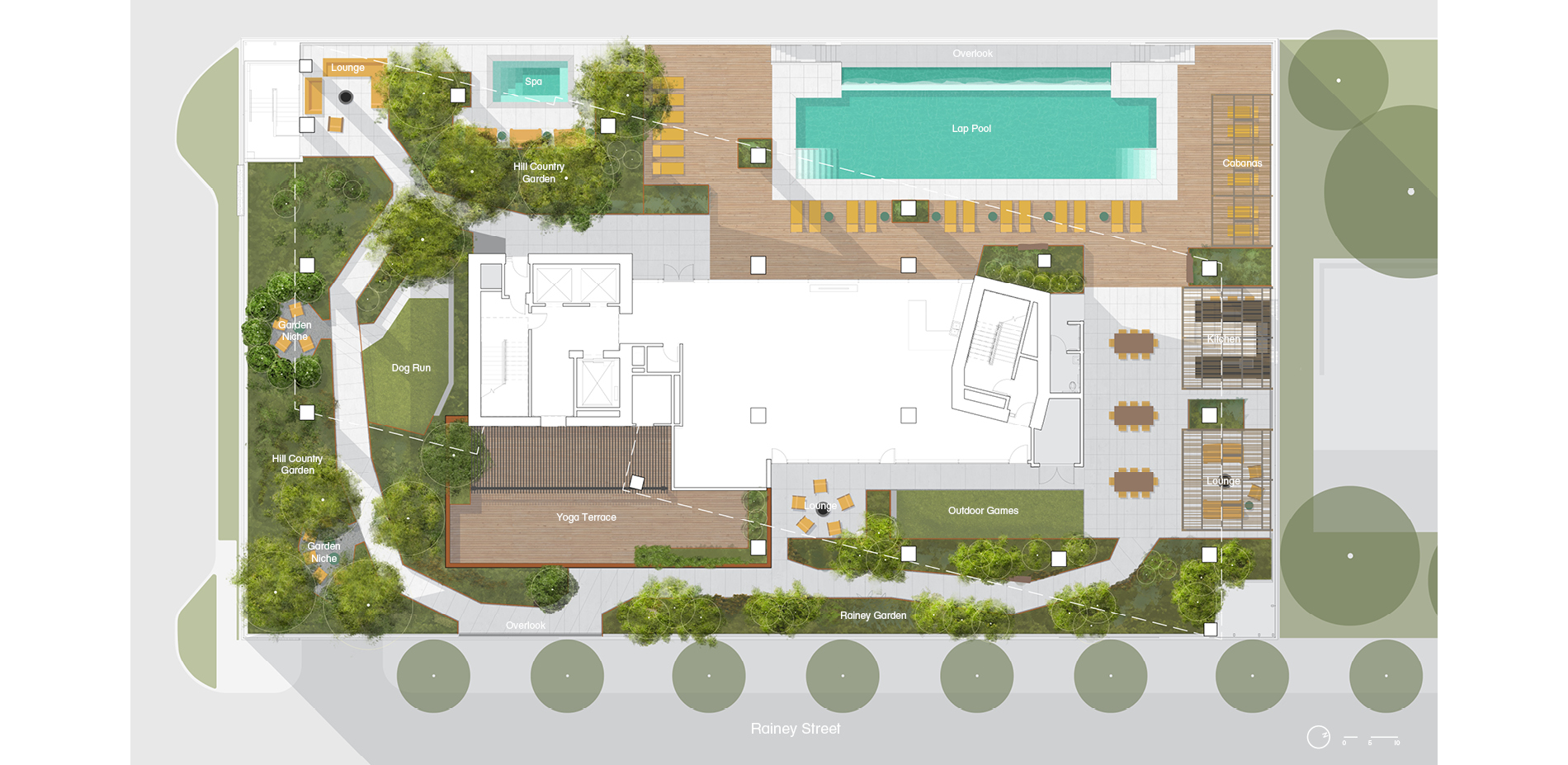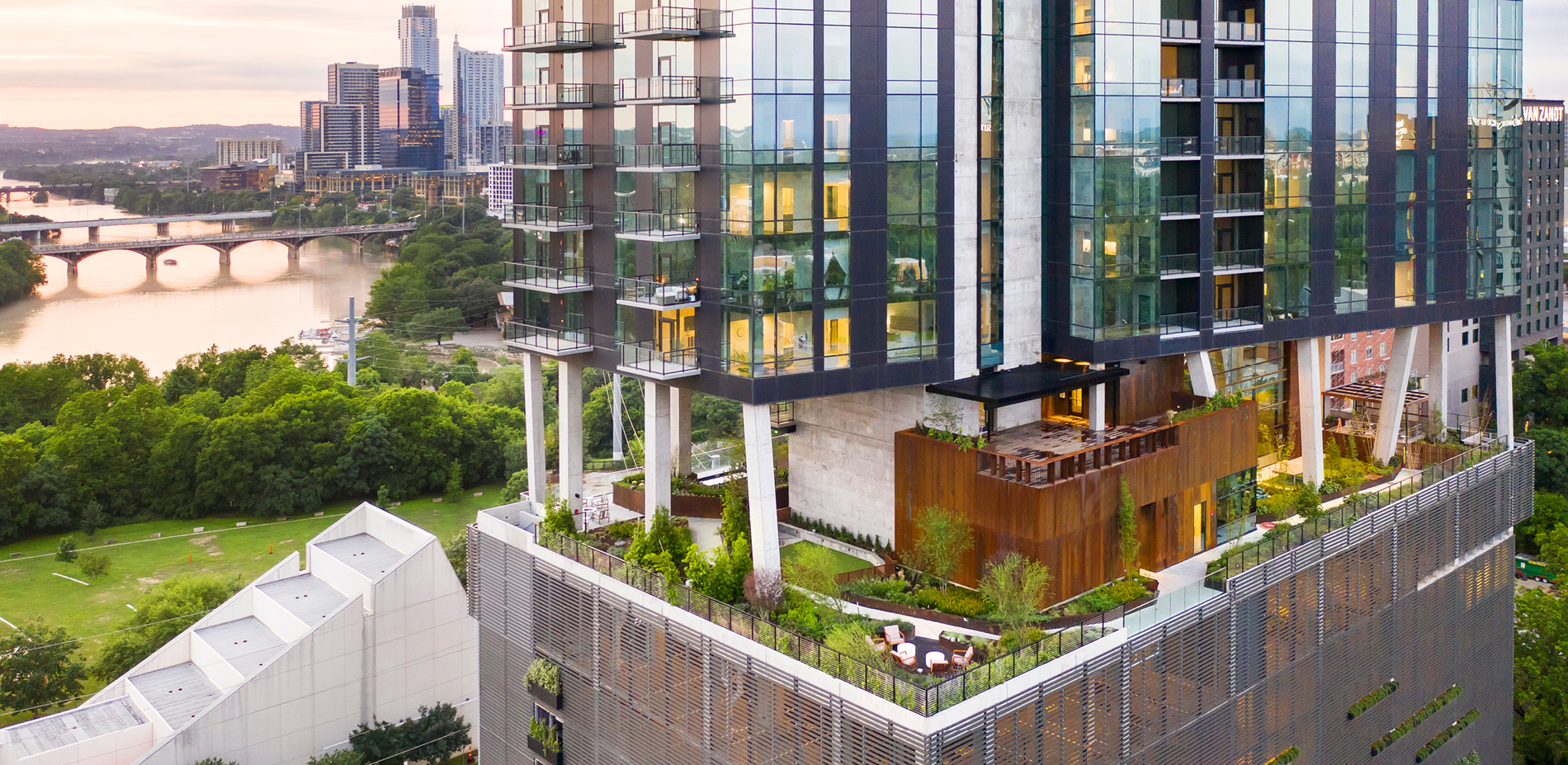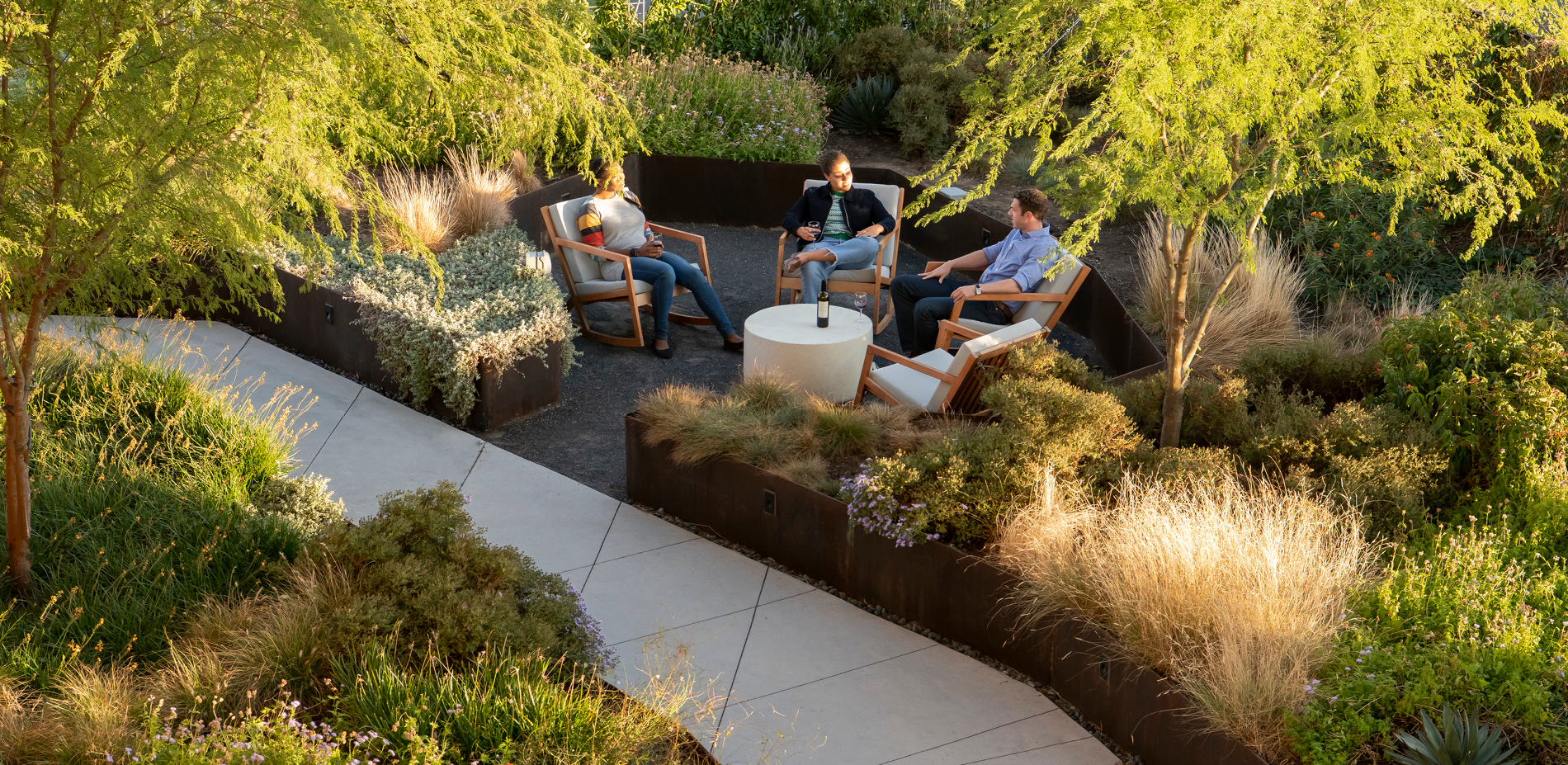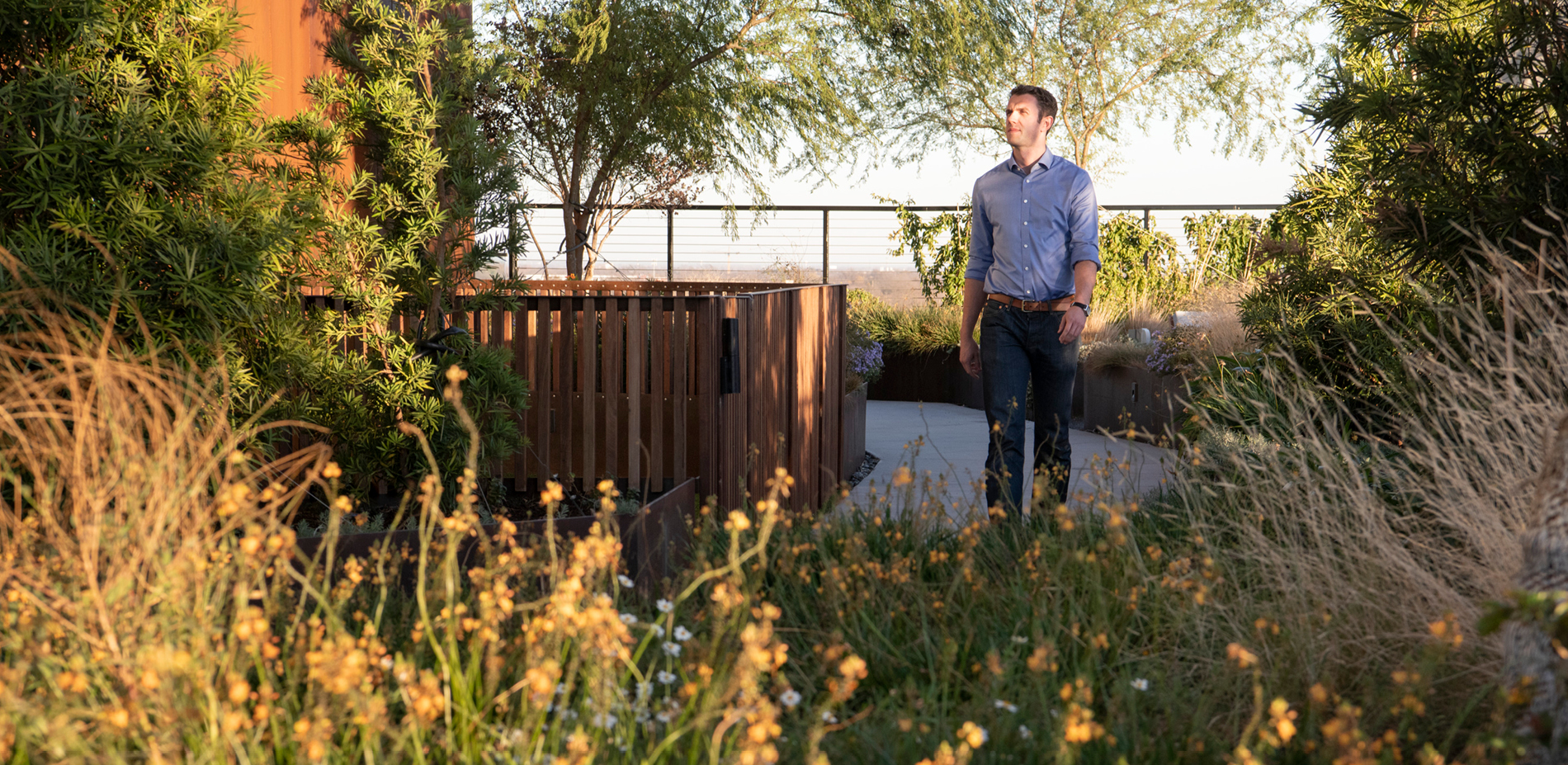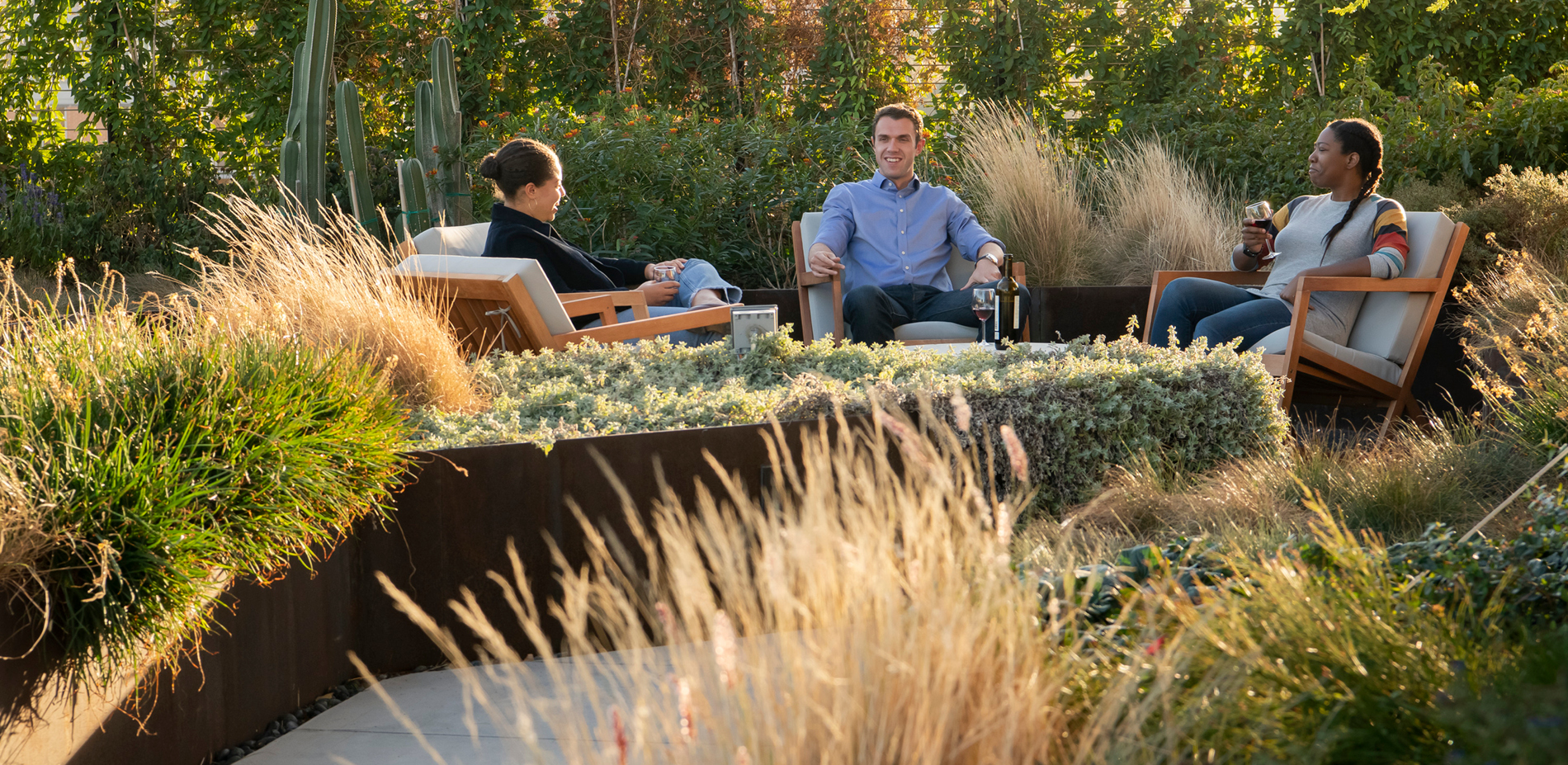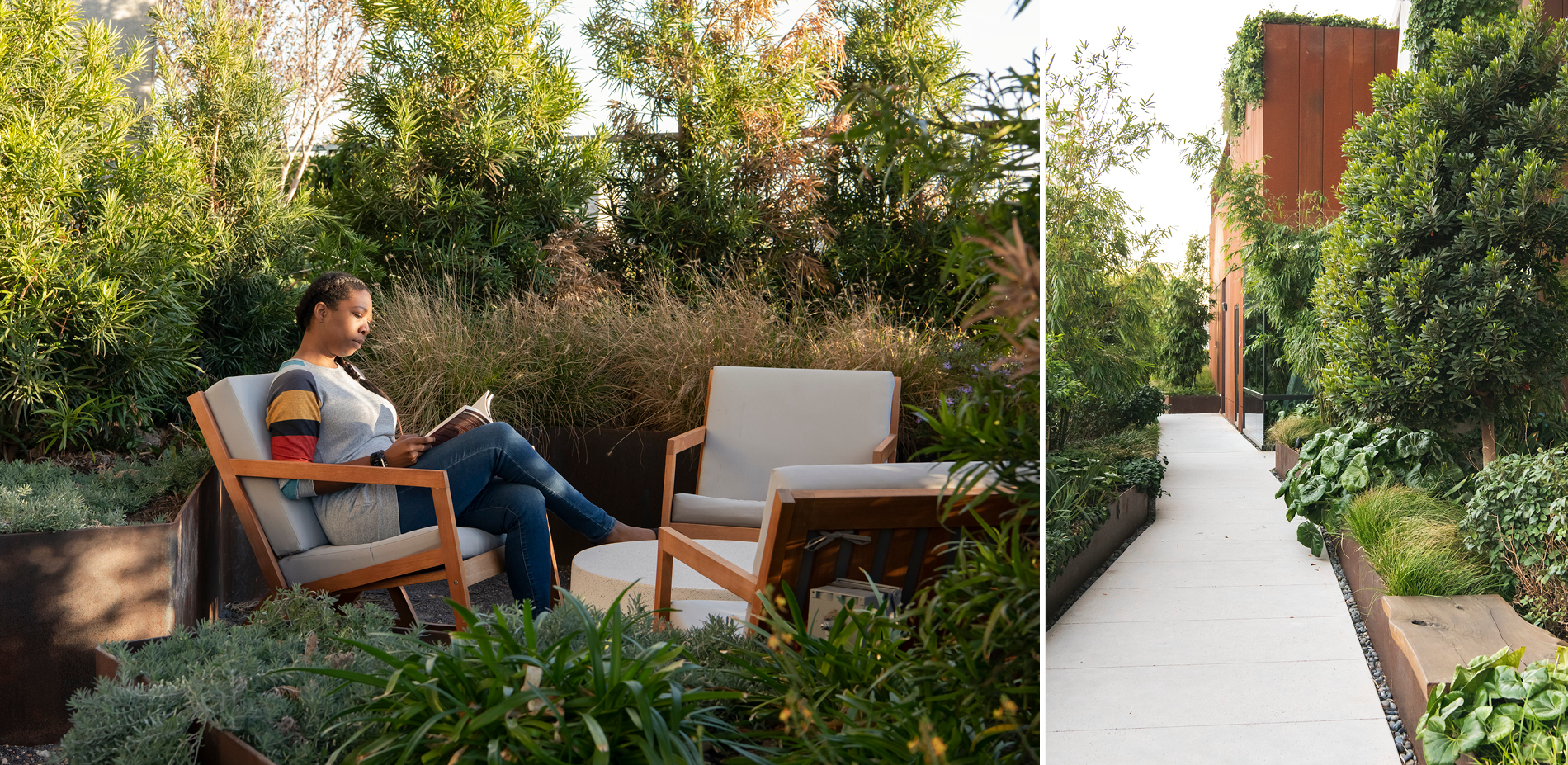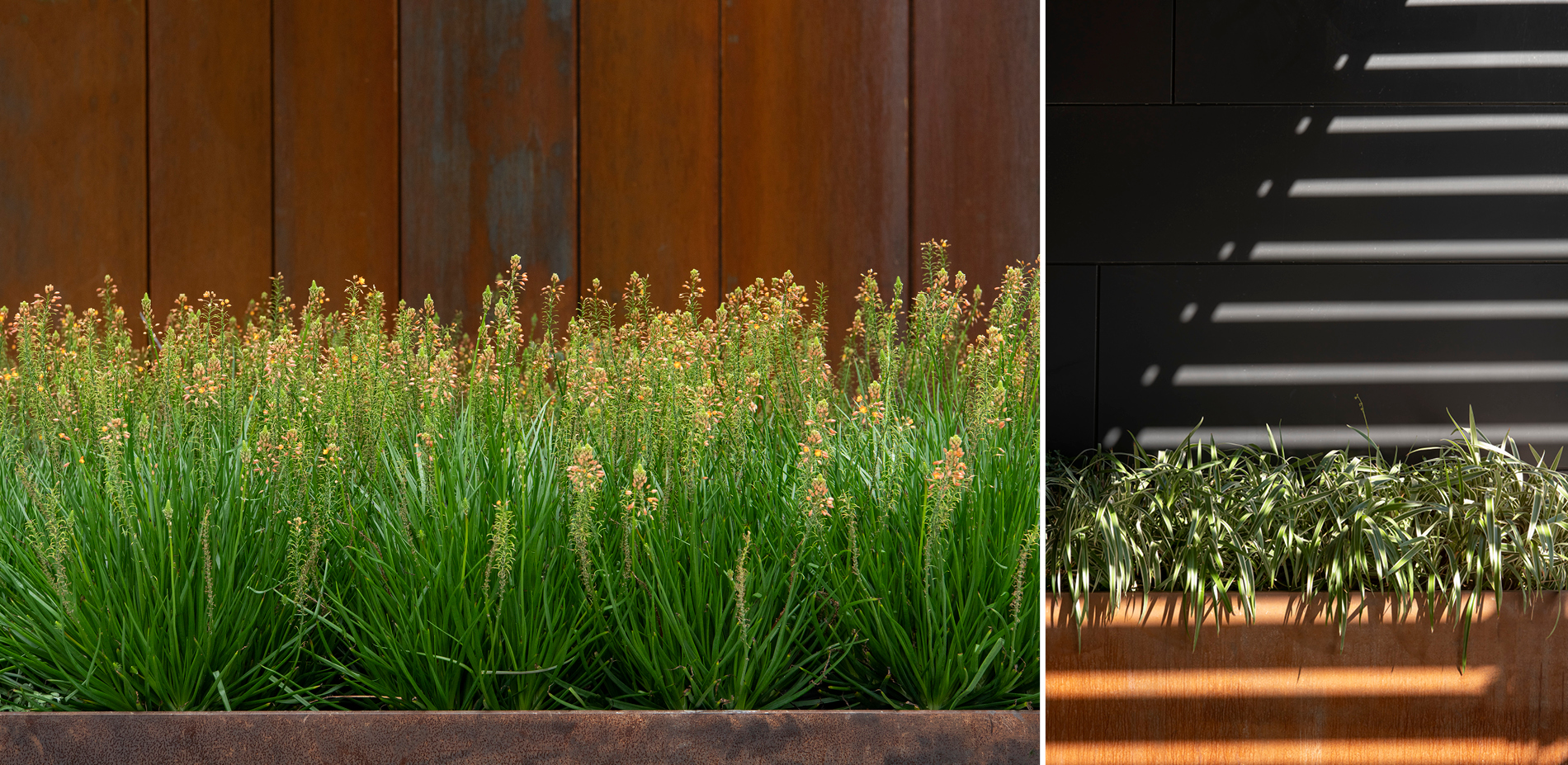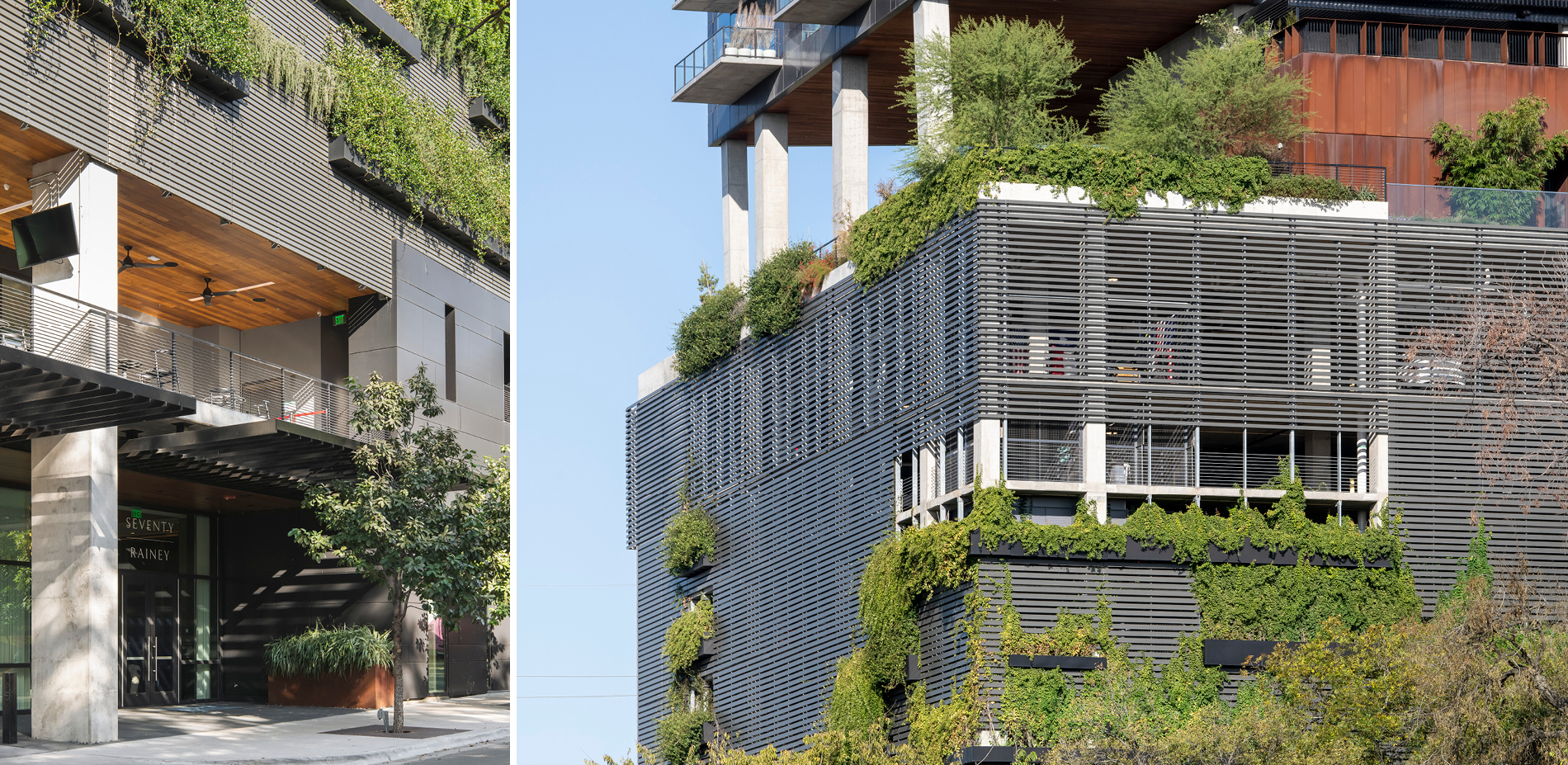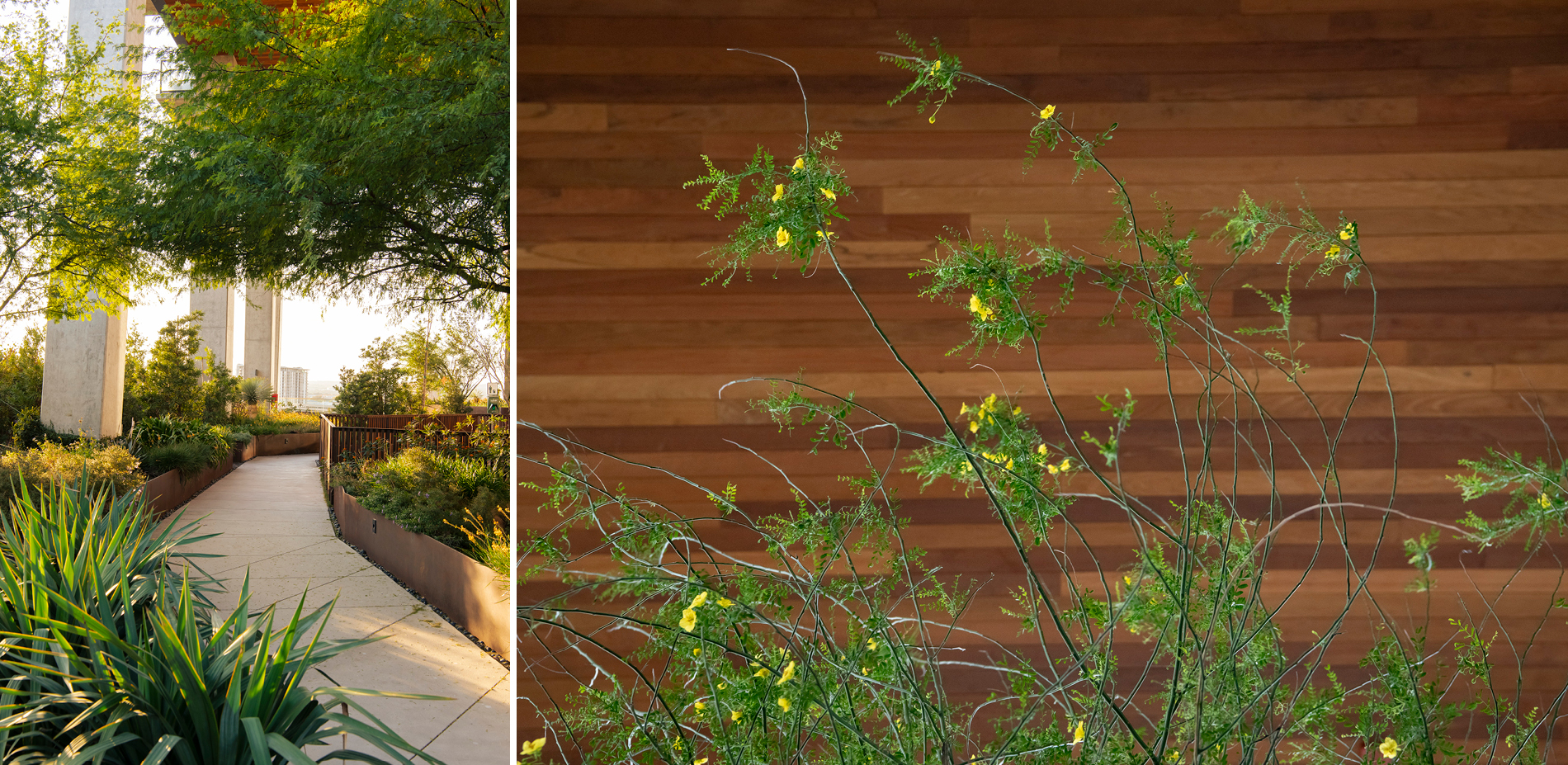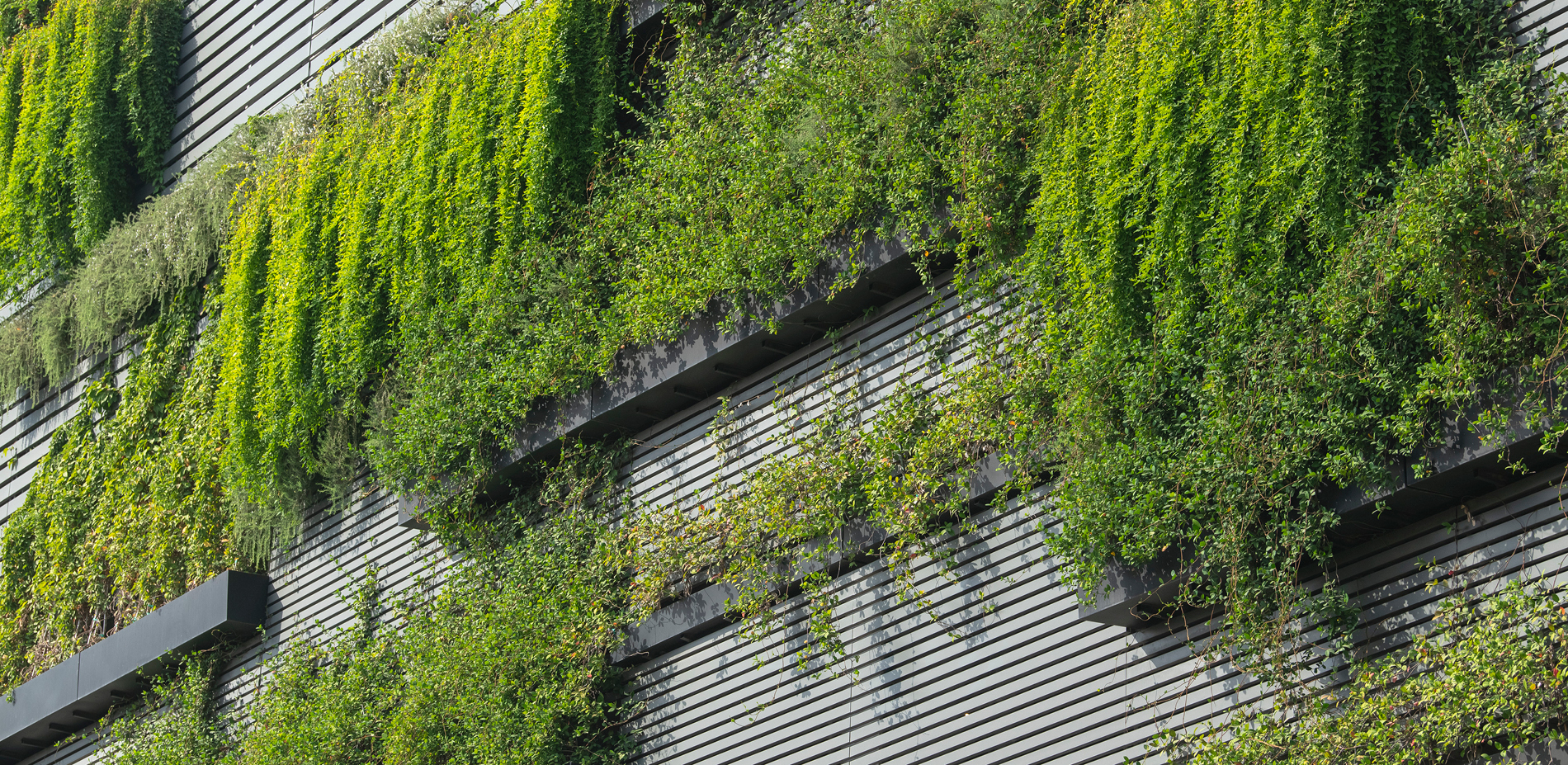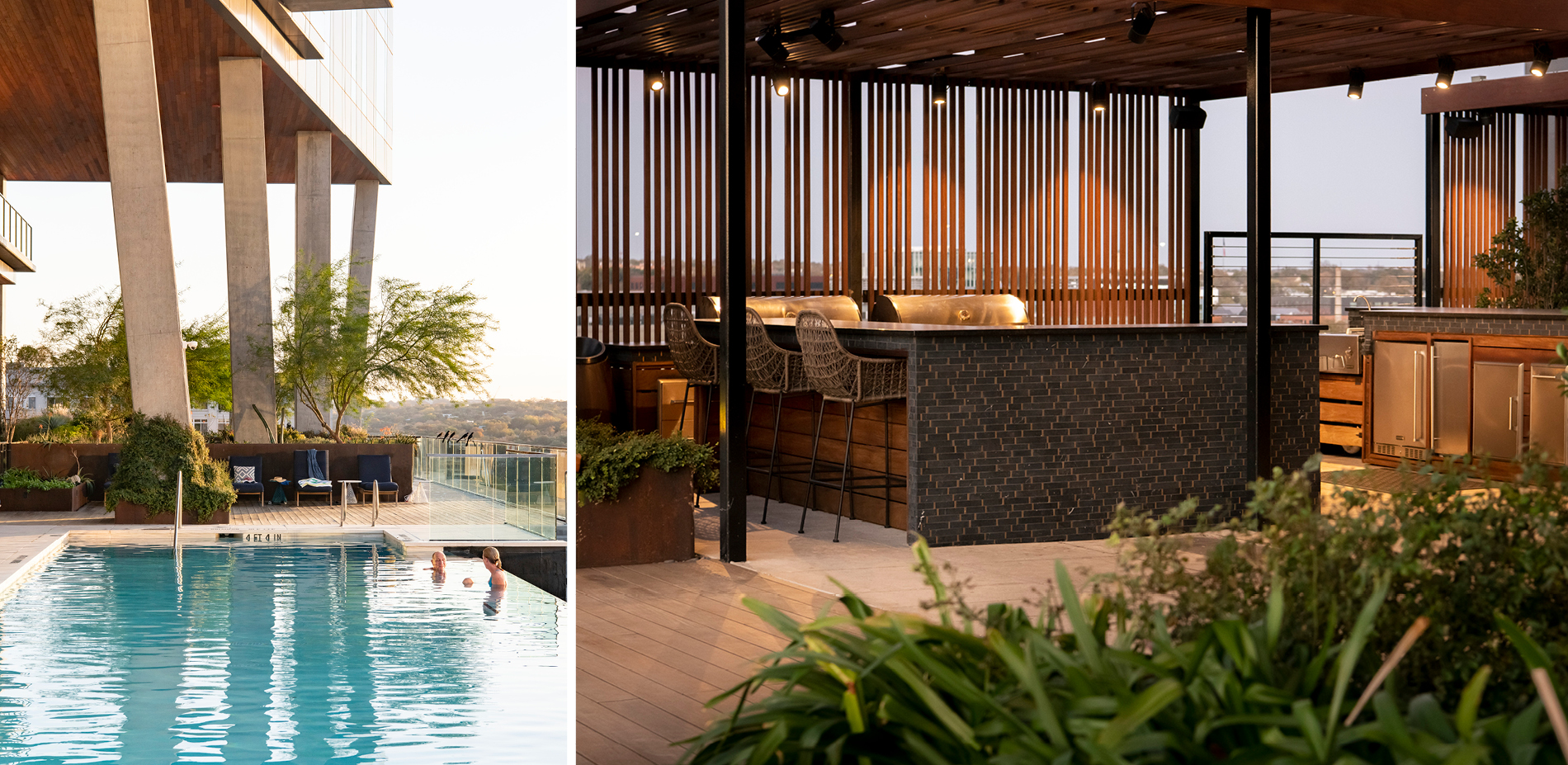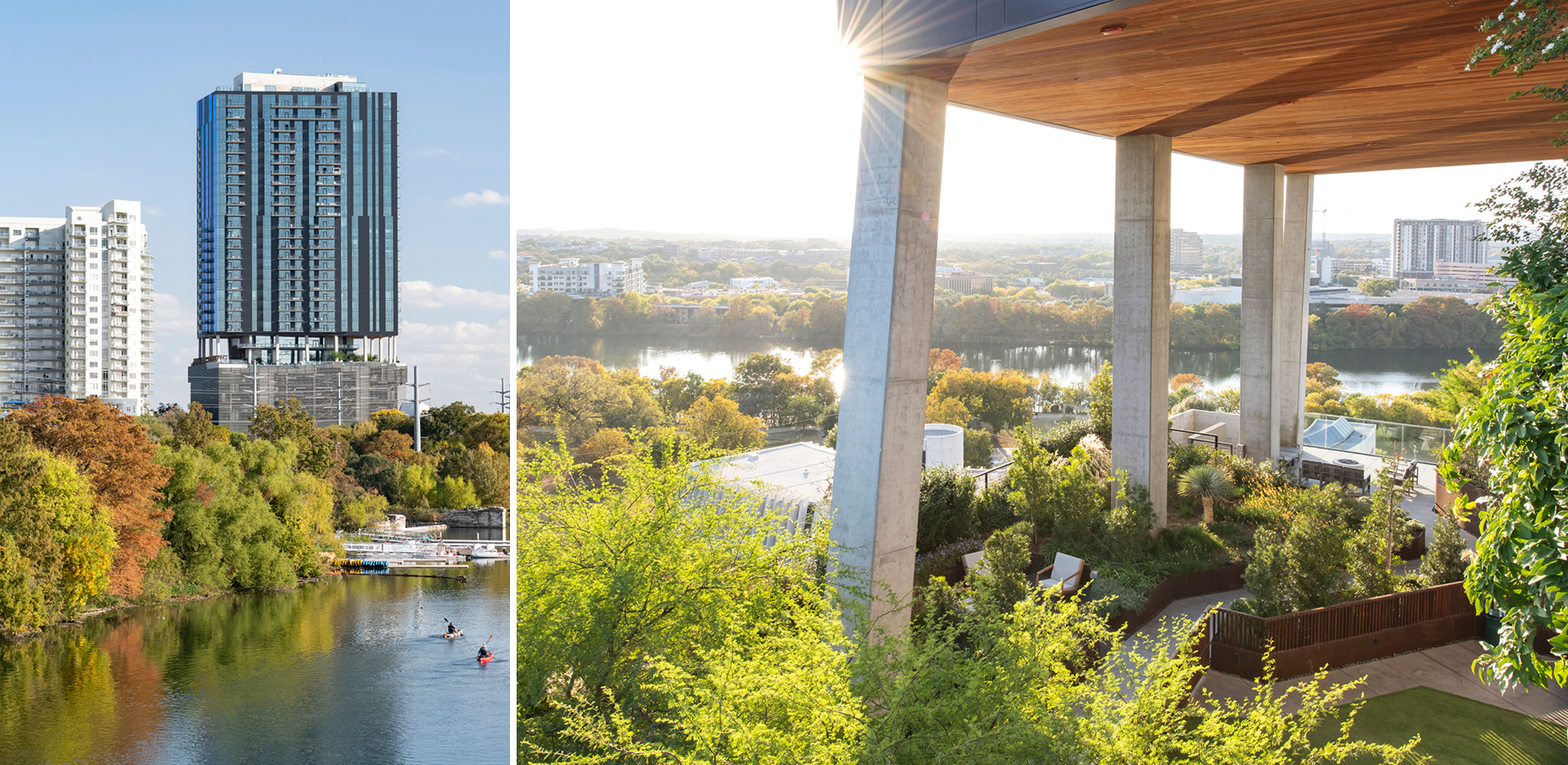The Sky Garden at 70 Rainey
Award of Excellence
Residential Design
Austin, Texas, United States
Design Workshop, Inc.
Client: Sackman Enterprises
If the future of the planet involves high-rise living, there is also a need for elevated green spaces to counteract congestion with verdant, air-purifying sky gardens that allow infill buildings to provide their inhabitants with some semblance of connection to the land. 70 Rainey accomplishes part of this green equation by topping its nine-story garage with a garden that also serves as a buffer between space for vehicles and space for residents. Spread over 9,300 square feet of rooftop elevated 100 feet in the air, the Sky Garden at 70 Rainey mitigates stormwater runoff and propagates pollinator species, wrapping the garage in climbing vines that will eventually blend the tower’s base into the street-level tree canopy.
- 2021 Awards Jury
Project Credits
Claire Hempel, Philip Koske, Michael Piano, Kenley Reed, Steven Spears, Design Workshop, Inc. - Project Team
Mike Albert, Beau Burris, Corinne Odom, Design Workshop, Inc. - Award Submission Assistance
Page/, Architecture
Markzeff, Interior Designer
Cardno Haynes Whaley, Structural Engineer
Stantec, Civil/MEP Engineer
JAS Irrigation, Irrigation Designer
Water Design, Inc., Pool and Spa Engineer
Flintco, General Contractor
Brightview, Landscape Contractor
Project Statement
Soaring 100 feet above the shoreline of Austin’s Lady Bird Lake, 70 Rainey redefines multifamily urban living in a city experiencing rapidly changing technology, culture and innovation. Its Sky Garden, a verdant refuge devoted to recreation, leisure and contemplation, is defined by the diverse and native ecologies of the Texas Hill Country that weave together a sensorial outdoor living experience.
Sustainability, a priority from the outset, led to early microclimate testing, the inclusion of locally sourced pollinator species, and abundant absorbent surfaces that manage stormwater runoff from entering the critical watershed. A complex planting palette, comprised of more than 70 native species, provides an ever-changing and abundant display of regional flora along meandering paths, within secluded nooks, and, most transformational, upon vertical architectural facades. Multidisciplinary collaboration informed design decisions to ensure habitable spaces were tempered from the region’s intense sunlight and high-speed winds.
As cities around the world continue to expand, evolve and respond to climatic change, The Sky Garden at 70 Rainey sets a precedent for creatively and sustainably growing up rather than out.
Project Narrative
REDEFINING THE TEXAS DREAM
The stereotypical Texas dream of expansive private yards and sprawling homes in suburban communities is becoming outdated. The Sky Garden at 70 Rainey shifts that perspective to a template more appropriate for urban environments. Located in Austin, one of the next U.S. boomtowns, the Sky Garden sets a precedent for growing up rather than out, and creates a deliberate connection to the surrounding native landscape through careful plant selection. Recreating the Texas Hill Country landscape and utilizing nature as a healer and rejuvenator, the Sky Garden delivers flourishing and protective microclimates 100 feet in the expansive Texas sky.
THE NATIVE GARDEN ELEVATED
Aptly named, the Sky Garden is dominated by its flora and successfully captures the character of the Texas Hill Country, creating a scaled-down, urban and elevated version of the region’s sweeping landscapes. In every direction, the Sky Garden delivers stunning views of the Texas Hill Country and its greater ecology. Though famous for its rugged hills of limestone and granite, there is much to be said about the region’s vegetation. Plants in this part of the state are just as beautiful as they are useful, another defining characteristic of the approach to the Sky Garden’s design. Echinacea, Salvias, and Asclepias feed hungry pollinator insects in the spring. Yuccas endure extreme temperature swings and Huisache trees shade guests from the hot sun. The Sky Garden elegantly resembles and responds to not only its distant surroundings but its immediate ones also. In response to the building’s architectural cues, the design team curated a plant palette that successfully blends building and nature. Plants have grown wildly and abundantly since their installation, becoming more and more impressive over time.
ENGINEERED MICROCLIMATES FLOURISH AND PROTECT
Extensive measures were taken to ensure that the Sky Garden not only flourished but was protected from Texas’s often harsh and unpredictable elements. Wind tunnel test data revealed specific locations where turbulence would create unpleasant and uninhabitable conditions. The landscape architect invoked deliberate planting interventions to curb strong natural and man-made winds to create desirable and comfortable outdoor spaces. High-performing Crossvines climb the cable railing and provide year-round protection. From the street, the same vines are part of the screen plant composition that shields the east and south faces from wind and sun and ties the building’s podium screen to the Sky Garden. Native Huisache trees also play a major role in the success of the Sky Garden’s microclimates. Located in the southeastern corner, which receives over six hours of sunlight on 100+-degree Texas summer days, these trees create a second canopy that lowers temperatures on the amenity deck while allowing dappled sunlight to filter through the bipinnate leaves. These carefully considered design decisions bring the deck to a human scale and create an ideal space for enjoying the Sky Garden’s many offerings throughout the day.
Of the 9,300 square feet of rooftop exposed to the sky, over 43% is comprised of gardens and an infinity edge pool. Rainwater is slowed and absorbed by the amenity deck’s many planting areas, which help to reduce peak flow runoff to the City of Austin’s storm system and adjacent Lady Bird Lake, a reservoir dedicated to recreation and flood control. Other environmental benefits that can be attributed to the Sky Garden include reoxygenation and increased pollination.
LIFESTYLE REIMAGINED
Program on the amenity deck is inspired by the social and natural forces surrounding it. Austin’s Rainey Street district is a shady tree-lined street and one of the most visited entertainment districts in the city. Single-family bungalows turned indoor-outdoor bars and restaurants allow locals and visitors to enjoy the outdoors and fantastic porch weather that drive tourists to Austin. The Sky Garden emulates the special character of this burgeoning district. Along the building’s Rainey Street side, shady gathering spots foster community and encourage interaction, like the bustling street below. The south and west sides take full advantage of panoramic views with sculpted garden rooms and an infinity edge pool that appears to vanish into Lady Bird Lake below.
NATURE AS A HEALER AND REJUVENATOR
Perhaps most importantly, the Sky Garden provides a lush, open-air escape where residents can maintain their mental wellness, engage in recreation, and surround themselves with nature. The east side is an ideal location to begin one’s day watching the sunrise. Its garden rooms, brightened by natural light, are a perfect retreat for reading and contemplation on hot summer days. Breezes circulate and lift the scent of vibrant, colorful perennials, shrubs and grasses into the air, giving the plants lively movement. The west edge of the building captures astonishing views of the setting Texas sun, Lady Bird Lake, and the vast Austin skyline on any given evening.
As cities like Austin continue to grow, the Sky Garden at 70 Rainey will serve as an important case study for rooftop gardens. In an undeniably urban setting, the Sky Garden successfully recreates native and natural landscapes, revitalizes the environment, and provides a refuge for humans and flora alike.
Products
-
Furniture
- Forms + Surfaces
- Landscape Forms
- Dekko
-
Drainage/Erosion
- NDS
-
Fences/Gates/Walls
- Lonestar Decking
- Patriot Erectors, Inc.
- Kane Innovations
-
Irrigation
- Netafim
- Hunter
-
Lumber/Decking/Edging
- Lonestar Decking
- Bison
-
Structures
- Patriot Erectors, Inc.
- Lonestar Decking
-
Water Management/Amenities
- Diamond Brite
- Pentair
- BECSys
- Bison
- S.R. Smith
-
Green Roofs/Living Walls
- Carlisle Waterproofing
-
Soils
- CU Structural Soils
- Organics by Gosh
-
Hardscape
- Concrete Collaborative
- WhittelselyCapform, Inc.
- Davis Colors
- Burlington Stone
-
Lighting
- Vista
- Dals Lighting
- Ligman
- EJ Group, Inc.
-
Other
- Magnolia Turf
- Tournesol Siteworks
- Form and Fiber, Inc.
Plant List
- Lily-of-the-Nile
- Baby Pete Agapanthus
- Butterflyweed
- Japanese Box
- Little John Dwarf Bottlebrush
- Spreading Japanese Plum Yew
- Eastern Purple Coneflower
- Japanese Aralia
- White Gaura
- Firebush
- Blackfoot Daisy
- Wild Bergamot
- Yew Plum Pine
- Carolina Cherry Laurel
- Fountainbush
- Mealy Blue Sage
- Salvia ‘Indigo Spires’
- Mexican Bush Sage
- Aromatic Aster
- Mexican Marigold
- Society Garlic
- Brazilian Vervain
- Anacacho Orchid Tree
- Texas Persimmon
- Jerusalem Thorn
- Blonde Ambition Blue Grama Grass
- Cherokee Sedge
- Fescue ‘Elijah Blue’
- Liriope muscari ‘Aztec Grass’
- Melinis nerviglumis ‘Pink Crystals’
- Miscanthus sinensis ‘Morning Light’
- Devil’s Shoestring
- Cast Iron Plant
- Japanese Holly Fern
- Moneywort
- Lavender Cotton
- Gray Creeping Germander
- Wooly Stemodia
- Wood Fern
- Agave ‘Blue Glow’
- Harvard Agave
- Artichoke Agave
- Aloe ‘Blue Elf’
- Bulbine
- Ice plant
- Mexican Snowball
- Golden Barrel Cactus
- Ghost Plant
- Goldmoss Stonecrop
- Pale-leaf Yucca
- Beaked Yucca
- Crossvine
- Lady of the Night
- Creeping Fig
- Star Jasmine
- Gold Nugget Ice Plant
- Giant Leopard Plant
- Soft Leaf Yucca
- Fountainbush
